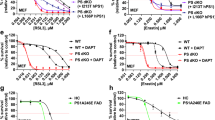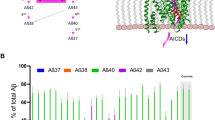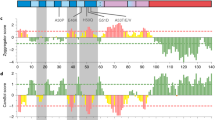Abstract
The presenilin proteins are components of high–molecular–weight protein complexes in the endoplasmic reticulum and Golgi apparatus that also contain β-catenin. We report here that presenilin mutations associated with familial Alzheimer disease (but not the non–pathogenic Glu318Gly polymorphism) alter the intracellular trafficking of β-catenin after activation of the Wnt/β-catenin signal transduction pathway. As with their effect on βAPP processing, the effect of PS1 mutations on trafficking of β-catenin arises from a dominant 'gain of aberrant function' activity. These results indicate that mistrafficking of selected presenilin ligands is a candidate mechanism for the genesis of Alzheimer disease associated with presenilin mutations, and that dysfunction in the presenilin–β-catenin protein complexes is central to this process.
This is a preview of subscription content, access via your institution
Access options
Subscribe to this journal
Receive 12 print issues and online access
$209.00 per year
only $17.42 per issue
Buy this article
- Purchase on Springer Link
- Instant access to full article PDF
Prices may be subject to local taxes which are calculated during checkout





Similar content being viewed by others
References
Sherrington, R. et al. Cloning of a gene bearing missense mutations in early onset familial Alzheimer's disease. Nature 375, 754–760 (1995).
Rogaev, E.I. et al. Familial Alzheimer's disease in kindreds with missense mutations in a novel gene on chromosome 1 related to the Alzheimer's Disease type 3 gene. Nature 376, 775–778 (1995).
Levy–Lahad, E. et al. A familial Alzheimer's Disease locus on–chromosome 1. Science 269, 970–973 (1995).
Levitan, D. & Greenwald, I. Facilitation of lin–12–mediated signalling by sel–12, a Caenorhabditis elegans S182 Alzheimer's Disease gene. Nature 377, 351–354 (1995).
Wong, P.C. et al. Presenilin 1 is required for Notch and Dll1 expression in the paraxial mesoderm. Nature 387, 288– 292 (1997).
Shen, J. et al. Skeletal and CNS defects in presenilin–1 deficient mice. Cell 89, 629–639 (1997).
Wolozin, B. et al. Participation of Presenilin 2 in apoptosis: enhanced basal activity conferred by an Alzheimer mutation. Science 274, 1710–1713 (1996).
De Strooper, B. et al. Deficiency of presenilin 1 inhibits the normal cleavage of amyloid precursor protein. Nature 391, 387–390 (1998).
Scheuner, D. et al. Secreted amyloid–β protein similar to that in the senile plaques of Alzheimer Disease is increased in vivo by presenilin 1 and 2 and APP mutations linked to FAD. Nature Med. 2, 864–870 (1996).
Citron, M. et al. Mutant presenilins of Alzheimer's Disease increase production of 42 residue amyloid β–protein in both transfected cells and transgenic mice. Nature Med. 3, 67– 72 (1997).
Borchelt, D.R. et al. Familial Alzheimer's disease linked presenilin 1 variants elevate Aβ1–42/1–40 ration in vitro and in vivo. Neuron 17, 1005–1013 (1996).
Tan, Y., Hong, J., Doan, T., McConlogue, L. & Maltese, W.A. Presenilin–1 mutations associated with familial Alzheimer's Disease do not disrupt protein transport from the endoplasmic reticulum to the Golgi apparatus. Biochem. Biophys. Acta (Molecular Basis of Disease) 1407, 69–78 (1998).
Capell, A. et al. The proteolytic fragments of the Alzheimer's Disease associated presenilin–1 form heterodimers and occur as a 100–150 kDa molecular mass complex. J. Biol. Chem. 273, 3205– 3211 (1998).
Yu, G., et al. The presenilin 1 protein is a component of a high molecular weight intracellular complex that contains β-catenin. J. Biol. Chem. 273, 16470–16475 (1998).
Zhou, J. et al. Presenilin 1 interacts with a novel member of the armadillo family. NeuroReport (Fast Track) 8, 2085– 2090 (1997).
Tomita, T. et al. Molecular dissection of domains in mutant presenilin 2 that mediate overproduction of amyloidogenic forms of amyloid–beta–peptides. In ability of truncated forms of PS2 with FAD mutation to increase secretion of Aβ42. J. Biol. Chem. 273, 21153– 21160 (1998).
Steiner H. et al. Expression of Alzheimer's Disease associated presenilin–1 is controlled by proteolytic degradation and complex formation J.Biol.Chem. 273, 32322–32331 (1998).
L'Hernault, S.W.L. & Arduengo, P.M. Mutation of a putative sperm membrane protein in Caenorhabditis elegans prevents sperm differentiation but not its associated meiotic divisions. J. Cell Biol. 119, 55–69 (1992).
Fagotto, F., Gluck, U. & Gumbiner, B.M. Nuclear localization signal–independent and importin/karyopherin–independent nuclear import of β-catenin. Curr. Biol. 8, 181–190 (1998).
Barth, A.I., Nathke, I.S. & Nelson, W.J. Cadherins, catenins and APC protein: interplay between cytoskeletal complexes and signalling pathways. Curr. Opin. Cell Biol. 9, 683–690 (1997).
Kao, K.R., Masui, Y. & Elinson, R.P. Lithium induced respecification of pattern in Xenopus laevis embryos. Nature 322, 371–373 (1986).
Klein, P. & Melton, D. A molecular mechnaism for the effect of lithium on development. Proc. Natl. Acad. Sci. USA 93, 8455–8459 (1996).
Stambolic, V., Ruel, L. & Woodgett, J.R. Lithium inhibits glycogen synthase kinase–3 activity and mimics Wingless signaling in intact cells. Curr. Biol. 6, 1664–1668 (1996).
Bird, T.D. et al. Wide range in age of onset for chromosome 1 related familial AD. Ann. Neurol. 40, 932– 936 (1997).
Mattila, K. et al. The Glu318Gly mutation of the presenilin 1 gene does not necessarily cause Alzheimer's Disease. Ann. Neurol. 44 965–967 (1998).
Aberle, H., Bauer, A., Stappert, J., Kispert, A. & Kemler, R. β–catenin is a target for the ubiquitin–proteasome pathway. EMBO J. 16, 3797– 3804 (1997).
Brancolini, C., Lazarevic, D., Rodriguez, J. & Schneider C. Dismantling cell–cell contacts during apoptosis is coupled to a caspase–dependent proteolytic cleavage of β-catenin. J. Cell Biol. 139, 759–771 (1997).
Davis, J.A. et al. An Alzheimer's disease–linked PS1 variant rescues the developmental abnormalities of PS1 deficient embryos. Neuron 20, 603–609 (1998).
Hartmann, T. et al. Distinct sites of intracellular production for Alzheimer's Disease AB40/42–amyloid peptides. Nature Med. 3, 1016–1020 (1997).
Cook, D.G. et al. Alzheimer amyloid β(1–42) peptide is generated in the endoplasmic reticulum/intermediate compartment of NT2N cells. Nature Med. 3, 1021–1023 (1997).
Wild–Bode, C. et al. Intracellular generation and accumulation of amyloid beta–peptide terminating at amino acid 42. J. Biol. Chem. 272, 16085–16088 (1997).
Imahori, K. & Uchida, T. Physiology and pathology of Tau protein kinases in relation to Alzheimer's Disease. J. Biochem. 121, 179–188 (1997).
Aplin, A.E., Jacobsen, J.S., Anderton, B.H. & Gallo, J.C. Effect of increased glycogen synthase kinase–3 activity upon the maturation of the amyloid precursor protein in transfected cells. NeuroReport 8, 639–643 (1997).
Takashima, A. et al. Presenilin 1 associates with glycogen synthase kinase 3beta and its substrate Tau. Proc. Natl. Acad. Sci. USA 95, 9637–9641 (1998).
Irving, N.G. & Miller, C.C.J. Tau phosphorylation in cells transfected with wild–type or Alzheimer's Disease mutant Presenilin 1. Neurosci. Lett. 222, 71– 74 (1997).
Ahmed, Y., Hayashi, S., Levino, A. & Weischaus, E. Regulation of Armadillo by Drosophila APC inhibits neuronal apoptosis during retinal development. Cell 93, 1171–1182 (1998).
Uchida, N., Honjo, Y., Johnson, K.R., Wheelock, M.J. & Takeichi, M. The catenin/cadherin adhesion system is localized in synaptic juntions bordering transmitter release zones. J. Cell Biol. 135, 767–779 (1996).
Kengaku, M. et al. Distinct WNT pathways regulating AER formation and dorsoventral polarity in the chick limb bud. Science 280, 1274–1277 (1998).
Ananth, U.E.A. et al. Case report of two presenilin 1 (PS1) mutations in a family with early onset FAD. Neurology 50, PO4.111 (1998).
Dignam, J.D., Lebovitz, R.M. & Roeder, R.G. Accurate transcription initiation by RNA polymerase II in a soluble extract from isolated mammalian nuclei. Nucl. Acids Res. 11, 1475–1489 (1983).
Miller, J.R. & Moon, R.T. Analysis of the signalling activities of localization mutants of beta-catenin during axis specification in Xenopus. J. Cell Biol. 139, 229– 243 (1997).
Han, Y. & Brasier, A.R. Mechanism for biphasic Rel A–NF–kB1 nuclear translocation in tumour necrosis factor–alpha–stimulated hepatocytes. J. Biol. Chem. 272, 9825– 9832 (1997).
Acknowledgements
This work was supported by grants from the Medical Research Council of Canada, Alzheimer Association of Ontario, EJLB Foundation, Howard Hughes Medical Research Foundation, The Canadian Genetic Disease Network, Scottish Rite Charitable Foundation, the Helen B. Hunter Fellowship (G.Y.), the Peterborough–Burgess Fellowship (E.A.R.), and the University of Toronto Department of Medicine Postgraduate Fellowship (M.N.).
Author information
Authors and Affiliations
Corresponding author
Rights and permissions
About this article
Cite this article
Nishimura, M., Yu, G., Levesque, G. et al. Presenilin mutations associated with Alzheimer disease cause defective intracellular trafficking of β-catenin,a component of the presenilin protein complex. Nat Med 5, 164–169 (1999). https://doi.org/10.1038/5526
Received:
Accepted:
Issue Date:
DOI: https://doi.org/10.1038/5526
This article is cited by
-
Interaction of NF-κB and Wnt/β-catenin Signaling Pathways in Alzheimer’s Disease and Potential Active Drug Treatments
Neurochemical Research (2021)
-
Exploring the Role of PSEN Mutations in the Pathogenesis of Alzheimer’s Disease
Neurotoxicity Research (2020)
-
Restoring Wnt/β-catenin signaling is a promising therapeutic strategy for Alzheimer’s disease
Molecular Brain (2019)
-
The rise and fall of insulin signaling in Alzheimer’s disease
Metabolic Brain Disease (2016)
-
The FAM3 superfamily member ILEI ameliorates Alzheimer’s disease-like pathology by destabilizing the penultimate amyloid-β precursor
Nature Communications (2014)



